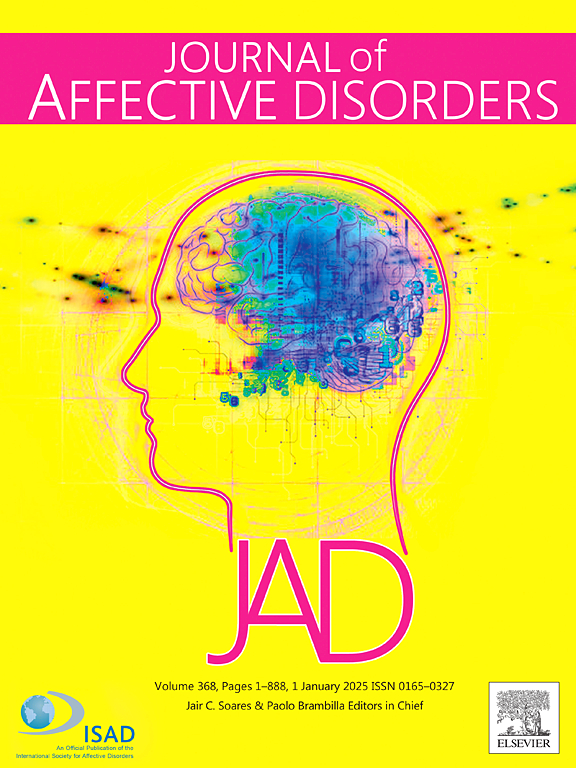利用父母体现心理评估™识别产后抑郁和合并症母亲的体现风险和保护因素
IF 4.9
2区 医学
Q1 CLINICAL NEUROLOGY
引用次数: 0
摘要
临床中,产后抑郁(PPD)常被诊断为母体共病性精神障碍(产后焦虑、PPA;母亲的人格障碍(pd)其与父母身具心智化(PEM)受损的关系尚不清楚。本研究旨在探讨产后抑郁症母亲父母心理化的具体风险因素和保护因素。更多的危险因素和更少的保护因素被假设为合并症的功能。方法对68名3-10月龄婴儿的母亲进行5分钟的自由游戏互动录像,采用父母具身心智化评估™(PEMA™)。根据DSM-IV诊断比较6个亚组:PPD;PPD和PPA;PPD和边缘性PD (BPD);PPD、PPA和BPD;PPD和其他pd;PPD, PPA和其他pd。结果总体而言,观察到可变亚组差异(d = 0.9-1.09): ppd母亲表现出最高的保护因素,而ppd母亲患有BPD的保护因素最低,特别是持续存在。患有PPA和其他pd的ppd母亲表现出最低的相互修复,而患有其他pd的ppd母亲表现出最高的连通性。在危险因素方面没有明显的组间差异。然而,患有BPD的ppd母亲表现出最高的戏弄和物化,即将婴儿视为无生命的物体。结论在PPD病例中,必须考虑合并症,因为它们主要影响母亲在婴儿期的具身交流的保护特性。共病性BPD与保护性因素较少、危险因素较多相关,而共病性PPA和/或其他pd与过度控制增加相关。需要进一步的研究来验证PEMA™因素,包括一个非临床对照组。本文章由计算机程序翻译,如有差异,请以英文原文为准。
Identifying embodied risk and protective factors in mothers with postpartum depression and comorbidities using Parental Embodied Mentalizing Assessment™
Background
Clinically, postpartum depression (PPD) is frequently diagnosed with maternal comorbid mental disorders (postpartum anxiety, PPA; personality disorders, PDs) in mothers. Its association with impaired Parental Embodied Mentalizing (PEM) remains unclear. This study aims to investigate embodied risk and protective factors of parental mentalizing in PPD-mothers. More risk factors and fewer protective factors were hypothesized as a function of comorbidities.
Method
Sixty-eight mothers with infants aged 3–10 months were examined using the Parental Embodied Mentalizing Assessment™ (PEMA™) on a 5-minute videotaped free-play interaction. Six subgroups were compared according to DSM-IV diagnoses: PPD; PPD and PPA; PPD and Borderline PD (BPD); PPD, PPA, and BPD; PPD and other PDs; and PPD, PPA, and other PDs.
Results
Overall, variable subgroup differences were observed (d = 0.9–1.09): PPD-mothers demonstrated the highest and PPD-mothers with BPD the lowest protective factors, in particular Sustained Presence. PPD-mothers with PPA and other PDs showed the lowest interactive Repair, and PPD-mothers with other PDs the highest Connectivity. There were no substantial group differences in risk factors. However, PPD-mothers with BPD displayed the highest Teasing and Objectification, i.e., treating the infant as an inanimate object.
Conclusion
In the case of PPD, comorbidities must be taken into account, as they primarily impact the protective character of the mother's embodied communication during infancy. Comorbid BPD is associated with fewer protective and more risk factors, whereas comorbid PPA and/or other PDs are associated with increased over-control. Further research is needed to validate the PEMA™ factors, including a non-clinical control group.
求助全文
通过发布文献求助,成功后即可免费获取论文全文。
去求助
来源期刊

Journal of affective disorders
医学-精神病学
CiteScore
10.90
自引率
6.10%
发文量
1319
审稿时长
9.3 weeks
期刊介绍:
The Journal of Affective Disorders publishes papers concerned with affective disorders in the widest sense: depression, mania, mood spectrum, emotions and personality, anxiety and stress. It is interdisciplinary and aims to bring together different approaches for a diverse readership. Top quality papers will be accepted dealing with any aspect of affective disorders, including neuroimaging, cognitive neurosciences, genetics, molecular biology, experimental and clinical neurosciences, pharmacology, neuroimmunoendocrinology, intervention and treatment trials.
 求助内容:
求助内容: 应助结果提醒方式:
应助结果提醒方式:


